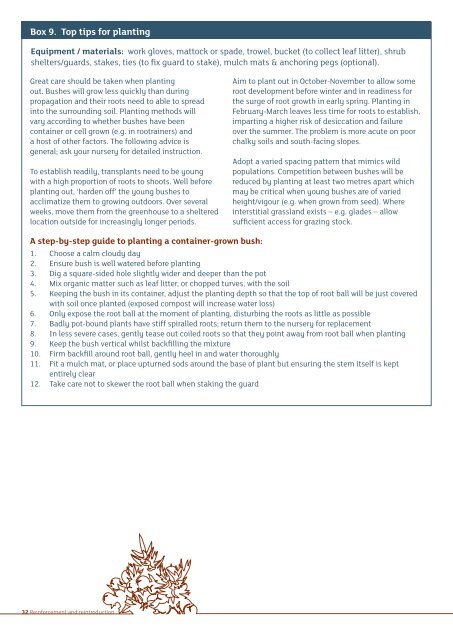Breaking new ground for juniper - Plantlife
Breaking new ground for juniper - Plantlife
Breaking new ground for juniper - Plantlife
- No tags were found...
Create successful ePaper yourself
Turn your PDF publications into a flip-book with our unique Google optimized e-Paper software.
Box 9. Top tips <strong>for</strong> plantingEquipment / materials: work gloves, mattock or spade, trowel, bucket (to collect leaf litter), shrubshelters/guards, stakes, ties (to fix guard to stake), mulch mats & anchoring pegs (optional).Great care should be taken when plantingout. Bushes will grow less quickly than duringpropagation and their roots need to able to spreadinto the surrounding soil. Planting methods willvary according to whether bushes have beencontainer or cell grown (e.g. in rootrainers) anda host of other factors. The following advice isgeneral; ask your nursery <strong>for</strong> detailed instruction.To establish readily, transplants need to be youngwith a high proportion of roots to shoots. Well be<strong>for</strong>eplanting out, ‘harden off’ the young bushes toacclimatize them to growing outdoors. Over severalweeks, move them from the greenhouse to a shelteredlocation outside <strong>for</strong> increasingly longer periods.Aim to plant out in October-November to allow someroot development be<strong>for</strong>e winter and in readiness <strong>for</strong>the surge of root growth in early spring. Planting inFebruary-March leaves less time <strong>for</strong> roots to establish,imparting a higher risk of desiccation and failureover the summer. The problem is more acute on poorchalky soils and south-facing slopes.Adopt a varied spacing pattern that mimics wildpopulations. Competition between bushes will bereduced by planting at least two metres apart whichmay be critical when young bushes are of variedheight/vigour (e.g. when grown from seed). Whereinterstitial grassland exists – e.g. glades – allowsufficient access <strong>for</strong> grazing stock.A step-by-step guide to planting a container-grown bush:1. Choose a calm cloudy day2. Ensure bush is well watered be<strong>for</strong>e planting3. Dig a square-sided hole slightly wider and deeper than the pot4. Mix organic matter such as leaf litter, or chopped turves, with the soil5. Keeping the bush in its container, adjust the planting depth so that the top of root ball will be just coveredwith soil once planted (exposed compost will increase water loss)6. Only expose the root ball at the moment of planting, disturbing the roots as little as possible7. Badly pot-bound plants have stiff spiralled roots; return them to the nursery <strong>for</strong> replacement8. In less severe cases, gently tease out coiled roots so that they point away from root ball when planting9. Keep the bush vertical whilst backfilling the mixture10. Firm backfill around root ball, gently heel in and water thoroughly11. Fit a mulch mat, or place upturned sods around the base of plant but ensuring the stem itself is keptentirely clear12. Take care not to skewer the root ball when staking the guardProtectionChoose guards that will be effective against the biggestand smallest herbivores on site. Pre<strong>for</strong>med shrub-shelterswith a diameter of 20-30cm and height of 60cm should suitmost circumstances, providing adequate protection againstrabbits, rodents and deer. Tree guards tend to be too narrowresulting in die-back and unnatural bush shapes that mayreduce survivorship once the guards are removed (Fig. 35).The ideal shrub-shelter material is a fine mesh that allowslight and air to penetrate but prevents shoots growingthrough. If herbicide is to be used to control weed growth,take precautions against spray drift. Avoid solid guards andfake meshes coated in plastic as they create warm humidconditions that may be suboptimal <strong>for</strong> <strong>juniper</strong>.Climatic Plus shelters (Figs. 36 & 37) have a proven trackrecord <strong>for</strong> <strong>juniper</strong> and are available from Trees Please(Northumberland): http://www.treesplease.co.uk/These guards are UV-biodegradable but are stated to lastmore than 10 years.Fitting a mulch mat /sheet will reduce root desiccation (themain reason <strong>for</strong> transplant failure) and reduce competitionfrom weeds (Fig. 37). Without mats, it may be necessary tomanually weed shelters although this can be a difficult andtime consuming task.Shelters should be double-staked and fitted tight tothe <strong>ground</strong> to exclude voles. After 5 years, shelters andmulch-mats should generally be removed and if necessaryreplaced with another means of protection.As well as presenting a barrier to herbivores, guardsstifle the wind. Buffeting of transplants can prevent rootestablishment. This is a particular problem on exposed siteswith thin rocky soils where bushes may be poorly anchoredafter planting. To prevent guards being blown over, ensurestakes are aligned with the prevailing wind.A good bespoke alternative is a post and rail triangleor square with toughened plastic/wire netting that canbe dug into the <strong>ground</strong>. Chicken wire should be avoidedbecause shoots grow through and become trapped (Fig. 38).Although post and rail constructions are more sturdy andstock-proof, considerable time and resources are needed,making them less practical <strong>for</strong> large planting schemes.On sites where guards are likely to attract complaints orvandalism, mounds of encircling spiny twigs offer a lessconspicuous alternative (Box 5).On stock-grazed land, a sturdy fenced exclosure or electricfence is best to eliminate the possibility of trampling andrubbing. When multiple threats exist, combinations ofrabbit netting and vole guards have been shown to be highlyeffective (see Grazing exclosures).© Jonathen Crewe© Jonathen Crewe© Jonathen CreweFigure 35. Tree guards encourage top-only growth,leading to a less resilient bush later on.Figure 36. Climatic Plus shrub shelter installed with twostakes and a mulch mat.Figure 37. View of mulch mat inside shelterFigure 38. Chicken wire provides some protection but isdifficult to remove in later years as shoots become entangled.32 Rein<strong>for</strong>cement and reintroduction<strong>Breaking</strong> <strong>new</strong> <strong>ground</strong> <strong>for</strong> lowland <strong>juniper</strong> 33
















